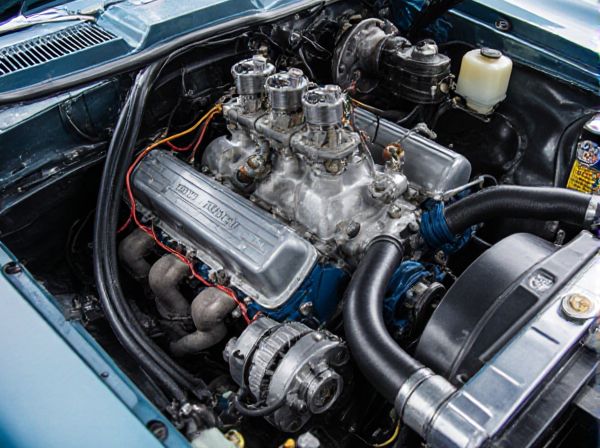
Photo illustration: Pushrod Valvetrain vs Dual Overhead Camshaft
Pushrod valvetrain systems offer a compact design with fewer moving parts, making them cost-effective and reliable for low to mid-range engine speeds. Dual overhead camshaft (DOHC) setups provide precise valve timing and higher RPM capabilities, improving performance and fuel efficiency in high-performance engines. Your choice depends on whether you prioritize simplicity and torque or advanced timing control and power output.
Table of Comparison
| Feature | Pushrod Valvetrain | Dual Overhead Camshaft (DOHC) |
|---|---|---|
| Camshaft Location | Inside Engine Block | Two Camshafts Located Above Cylinder Head |
| Valve Control | Pushrods Activate Valves | Direct Actuation of Valves |
| Engine Complexity | Simple Design | More Complex Mechanism |
| RPM Capability | Lower Maximum RPM | Higher Maximum RPM |
| Power Output | Moderate Power, Good Low-End Torque | Higher Power, Better High-End Performance |
| Maintenance | Less Maintenance, Easier Repairs | More Maintenance Required |
| Engine Size | Compact, Allows Smaller Engine Size | Larger Cylinder Head Design |
| Cost | Lower Production Cost | Higher Production Cost |
Introduction to Engine Valvetrain Architectures
Pushrod valvetrain architecture features a camshaft located within the engine block, actuating valves via lifters, pushrods, and rocker arms, resulting in a compact design ideal for V8 engines and lower RPM scenarios. Dual Overhead Camshaft (DOHC) setups place two camshafts per cylinder head, directly operating intake and exhaust valves, enabling precise valve timing, higher RPMs, and improved airflow efficiency. The choice between pushrod and DOHC valvetrains significantly impacts engine performance, manufacturing complexity, and maintenance requirements.
What is a Pushrod Valvetrain?
A Pushrod Valvetrain is a type of engine valve system where the camshaft is located within the engine block, using pushrods to transfer motion to the rocker arms and open the valves. This design typically results in a more compact engine layout with fewer moving parts compared to Dual Overhead Camshaft (DOHC) systems, which place the camshafts directly above the valves. Pushrod valvetrains are often found in American V8 engines and provide high low-end torque with simpler manufacturing and maintenance.
What is a Dual Overhead Camshaft (DOHC) System?
A Dual Overhead Camshaft (DOHC) system features two camshafts per cylinder bank, with one operating the intake valves and the other controlling the exhaust valves, enabling more precise valve timing and improved engine breathing. This configuration enhances performance and efficiency by allowing higher engine speeds and better airflow compared to pushrod valvetrain systems that use a single camshaft within the engine block. DOHC engines are commonly found in modern high-performance and fuel-efficient vehicles due to their capability to optimize combustion and power output.
Design Differences: Pushrod vs DOHC
Pushrod valvetrains feature a camshaft located within the engine block, using pushrods and rocker arms to actuate the valves, resulting in a more compact and simpler design. Dual Overhead Camshaft (DOHC) systems place two camshafts directly above the cylinder head, allowing for more precise valve timing and typically supporting four valves per cylinder for improved airflow and performance. The design differences impact engine height, complexity, and potential RPM range, with DOHC setups offering greater flexibility for high-performance applications.
Performance Advantages of Pushrod Engines
Pushrod valvetrain engines offer superior low-end torque and a more compact design, enhancing vehicle packaging and weight distribution compared to dual overhead camshaft (DOHC) engines. Their simpler valvetrain architecture reduces mechanical complexity, leading to increased durability and lower manufacturing costs. Pushrod engines excel in applications requiring robust torque delivery at lower RPMs, making them ideal for trucks and muscle cars focused on raw power rather than high-rev performance.
Performance Benefits of DOHC Engines
Dual Overhead Camshaft (DOHC) engines offer superior performance benefits compared to Pushrod Valvetrain systems by enabling higher engine speeds and improved valve timing precision. DOHC configurations allow for more efficient airflow with four valves per cylinder, enhancing combustion efficiency and power output. This results in better acceleration, increased horsepower, and improved fuel efficiency, making DOHC engines ideal for high-performance applications.
Reliability and Maintenance Comparison
Pushrod valvetrain systems exhibit superior reliability due to their simpler design and fewer moving parts, minimizing potential failure points and easing maintenance requirements. Dual overhead camshaft (DOHC) configurations offer enhanced performance and valve control but involve more complex timing mechanisms that demand meticulous maintenance and higher service costs. The pushrod setup's lower maintenance intervals and robustness make it preferable for long-term durability, while DOHC engines require more frequent inspections and precise adjustments to sustain optimal operation.
Cost and Manufacturing Considerations
Pushrod valvetrain systems generally offer lower manufacturing costs due to their simpler design and fewer components, making them ideal for mass-produced vehicles with budget constraints. Dual overhead camshaft (DOHC) configurations involve more complex machining and assembly processes, leading to higher production expenses but allowing for enhanced engine performance and efficiency. The cost-benefit balance often drives manufacturers to choose pushrod designs for economical models, while DOHC systems are preferred in performance-oriented and luxury vehicles.
Applications: Where Each Valvetrain Excels
Pushrod valvetrains excel in applications with compact engine designs, such as trucks and muscle cars, where simplicity and torque at low RPMs are prioritized. Dual overhead camshaft (DOHC) setups dominate high-performance sports cars and motorcycles, offering precise valve timing and higher RPM capabilities for maximum power output. Pushrod engines favor durability and cost-effectiveness in heavy-duty vehicles, while DOHC engines deliver superior efficiency and responsiveness in racing and luxury automobiles.
Final Verdict: Choosing Between Pushrod and DOHC
The choice between pushrod valvetrain and dual overhead camshaft (DOHC) depends on desired performance and engine design priorities; pushrod systems offer a compact design with fewer moving parts, typically resulting in lower production costs and enhanced low-end torque. DOHC configurations enable higher RPM limits and improved airflow for increased horsepower and efficiency, making them ideal for performance-oriented and modern engines. For practical daily driving and cost-effectiveness, pushrod engines are advantageous, whereas DOHC engines excel in applications demanding maximum power and refined valve timing control.
 caratoz.com
caratoz.com